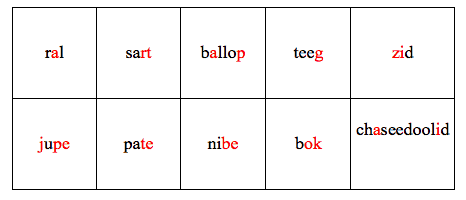With the incredibly diverse populations we work with, it’s important we have a toolkit full of ways to help us differentiate language differences from language disorders. Non-word repetition tasks have been found to be good tools. Children with language impairment have significantly lower performance on non-word repetition tasks than their peers with typical development.
Non-word Repetition Tasks Tap Into Skills Underlying Word Learning
Think of all of the skills that are required to listen to a word (or non-word) and repeat it back. We have to perceive the set of sounds, encode them, remember them, assemble the sounds for production, and articulate them. These are all skills that we use to learn words. If our ability to perform any one of those skills is impaired, we will not perform well on non-word repetition tasks.
Non-word Repetition Tasks Reduce Bias
The use of non-words reduces bias related to life experiences, socialization practices, and literacy skills. These types of tasks do not rely on prior experiences to the extent that many formal and informal assessment tasks do.
Non-word Repetition Tasks Have Been Found to Be Effective Across Many Languages
The use of non-word repetition tasks have been found to be effective with children who speak English, Spanish, Italian, Dutch, French, and Mandarin (Paradis, Schnieder& Sorenson, 2013; Dispaldro, Leonard, and Deevy, 2013; Dollaghan & Campbell, 1998; Stokes, Wong, Fletcher & Leonard, 2006).
Be Mindful of Phonotactic Constraints
Someone recently asked me about using the CTOPP Non-Word Repetition Task with a child whose native language is Spanish. They reasoned that if the words are non-words, what difference does it make. I explored the CTOPP-2, published by PRO-ED, which has a non-word repetition task. The manual doesn’t state the language(s) spoken by the individuals in the standardization sample, so I will assume it was normed on monolingual English speakers. When I went through the word list I found that all of the non-words conform to the phonotactic constraints of English. This isn’t the case for Spanish, however.
Take a look at the first 10 words. Every single one of them includes either a sound that does not exist in Spanish, a sound in a word position it cannot be in in Spanish, or a sound combination that does not exist in Spanish. I’ve marked those in red.

Think about the impact of that on a Spanish speaker. What if you were asked to repeat a list of non-words that conformed to the phonotactic constraints of German or Hebrew. Do you think it would be harder for you than a list of nonword that conformed to English phonotactic constraints? You bet. So the same rules hold for standardized tools for non-word repetition tasks that hold for standardized tools in general. If you use them with individuals who are not represented in the standardization sample, you can throw the scores out of the window.
You can certainly design non-word repetition tasks that are appropriate for your students who speak a language other than English as their native tongue. Use the phonotactics section in each chapter of the Difference or Disorder book to guide you.
.



I have been trying to use a non-word repetition task but don’t have an appropriate list of non-words appropriate for Spanish speakers.
Does anyone have one already that could share with me?
Thanks!!!!
Cate Crowley did a presentation at ASHA in 2017 that includes a list of non-words for Spanish. She referenced:
Ebert, Kelly, Rohnert (2008). Spanish nonword repetition: Stimuli development and preliminary results. Communication Disorders Quarterly,28(2), 67-74.
Guiberqson, M. & Rodriguez, B (2013). Classification accuracy of nonword repetition when used with preschool-age Spanish-speaking children. Language Speech and Hearing Services in Schools, 44, 121-132.
Sounds like a great idea! How would you write this up in a report? What research study should we credit with distinguishing a language disorder from difference using this method? What is the criteria?
See references below. Also:
Dollaghan & Campbell (1998). Nonword Repetition and Child Language Impairment. JSLRR, 41,5, 1136.
Gutierrez-Clellen, V. & Simon-Cereijido, G. (2010). Using nonword repetition tasks for the identification of language impairment in Spanish-English speaking Children. Does the language of assessment matter? Learning Disabilities Research and Practice, 24(1), 38-58.
I’ll do another post that includes criteria used and how to write it up.
I’m just now looking at this post. Did you by any chance write another post including the criteria and how to write this up in an evaluation?
Hi Diana,
Here’s a quick sample of a write-up. I’ll also send you a document that has been used by some of the districts we’ve worked with. I added this write-up at the end of it too.
A non-word repetition task was implemented to explore Student’s ability to hear and repeat words of varying complexity and length. This type of task reduces bias in the assessment process because it does not rely on prior experiences and it allows us to view a student’s ability to perceive a set of sounds, encode them, remember them, assemble the sounds for production, and articulate them. These are all tasks necessary for learning language. The task starts with simple, single-syllable words and moves to increasingly complex words. This allows us to see the level at which a student has difficulty.
On this task, Student produced all sounds at the 1- and 2-syllable word level. At the 3-syllable word level, he produced 90% of consonants correctly. At the 4-syllable level he produced 28% of consonants correctly. In order to determine what aspect was difficult for Student at the 4-syllable word level, a discrimination task was implemented. The examiner read two 4-syllable non-words and asked Student to tell if they were the same or different. Student’s accuracy at the 4-syllable level on the discrimination task was 30%, suggesting that perceiving and/or remembering that much information is difficult. The use of visual supports in the classroom may benefit student in learning new information.
I’d definitely pay $$ for a good nonword list with Spanish phontactics along with norms. I don’t feel confident comparing nonword acquisition of individuals with an LD vs typically developing children with an informal test. How can I score that? If you guys made the resource, I’d buy it!
I’ll put it on my to-do list!
I wish this title were more representative of the content. It would be more accurate to say “Does Non-Word Repetition Necessarily Help Differentiate Language Difference from Language Disorder?” Because the answer is, “Depends on the phonotactics used to shape the non-words and the native phonology of the examinee.”
You make a good point!
I work at a Chinese Immersion school as an English only speaking SLP. Most of our population’s first language is English. Only about 5% is Asian and 2% other first languages. Math and Science are taught in Chinese with 75% of the day being in Kindergarten- 1st grade. 2nd grade and up 50% of their day is in Chinese. As you can imagine, things might get complicated in the evaluation process or if a child has an SLD or LD. I thought that using the CTOPP Non-word list might be a predictor of ability to learn a second language, but now I see I was incorrect since the phonotactics are English based, so thanks so much for this valuable information! I’m wondering if anyone has some good ideas on how I would differentiate language difference from the disorder for ELL students as well as a Chinese list of words that are non-words for native English speakers to gauge their propensity for learning Chinese. Please feel free to add other considerations that you think would be important in the evaluatoin process. Thanks in advacne for your help!
Hi Lisa,
What an interesting setting you work in. There is certainly support for the idea that there is a relationship between vocabulary acquisition and phonological working memory. A number of studies have explored Baddeley’s (1986, 1990) theory of phonological working memory and have found those relationships. I think it would be a stretch though to use the CTOPP to gauge a child’s propensity for learning Chinese given the CTOPP’s English-based design. I don’t know of any tools designed to do that. Readers??? Any ideas?
Hello,
Thank you very much for this post. I am a graduate student, and I am learning to do bilingual evaluations. I have been using the non-word repetition task, but it is hard for me to know what is typical or atypical. Is there any criteria (e.g. what percentage of PPC is considered writing normal limits?). Any information would be greatly appreciated.
Hi Yennin,
Read through the comments and responses of this post. There are a few great resources that touch on what to look for.